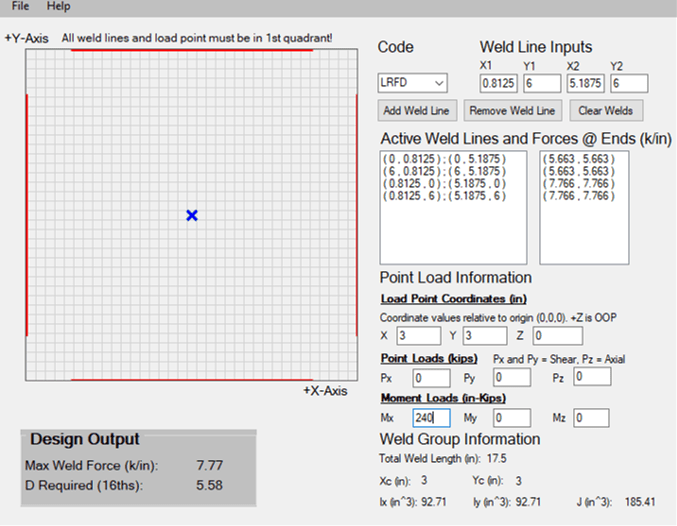RabitPete
Structural
- Nov 24, 2020
- 109
Hoping someone could double check my math here, I am doing everything by AISC books and can not match the results with RISA connections.
6x6x1/4 HSS subject to 240 kip-in load. 46ksi yield/58 ksi ultimate
5/16 weld (0.22 throat) Fexx=70
Since HSS wall thickness is 0.23 and 5/16 weld would not be develop Fexx, effective weld size Deff=4.31 and effective throat=0.191
Available weld strength ϕRn = 1.392*4.31 = 6 kip/in
Calculating moment of inertia: I=2(6^3*0.191/12+6*0.191*(6/2)^2) = 27.5 in4
And required weld strength for out of plane force per unit length: Ro=240/27.5*(6/2) * 0.191 = 5.0 kip/in
Now I am trying to calculate 2 connection in Risa connections. Available weld strength matches Risa results for different HSS, different weld sizes, so no questions here. Now required weld strength is a completely different animal. For the same conditions, Risa gives Ro=7.89 kips/in.
Moreover, my Ro does not change with the column thickness, while theirs does, e.g. 6x6x1/2 needs 9.66 kip/in while 6x6x1/8 only 7.23 kip/in
Are they accounting for ineffective length? I though it only applied to HSS-HSS welds. And if they do account for it, Ro would depend on base plate thickness and changing base plate does not seem to affect the results. Difference between 5 kip/in and 8 kip/in is substantial. What is the catch???
6x6x1/4 HSS subject to 240 kip-in load. 46ksi yield/58 ksi ultimate
5/16 weld (0.22 throat) Fexx=70
Since HSS wall thickness is 0.23 and 5/16 weld would not be develop Fexx, effective weld size Deff=4.31 and effective throat=0.191
Available weld strength ϕRn = 1.392*4.31 = 6 kip/in
Calculating moment of inertia: I=2(6^3*0.191/12+6*0.191*(6/2)^2) = 27.5 in4
And required weld strength for out of plane force per unit length: Ro=240/27.5*(6/2) * 0.191 = 5.0 kip/in
Now I am trying to calculate 2 connection in Risa connections. Available weld strength matches Risa results for different HSS, different weld sizes, so no questions here. Now required weld strength is a completely different animal. For the same conditions, Risa gives Ro=7.89 kips/in.
Moreover, my Ro does not change with the column thickness, while theirs does, e.g. 6x6x1/2 needs 9.66 kip/in while 6x6x1/8 only 7.23 kip/in
Are they accounting for ineffective length? I though it only applied to HSS-HSS welds. And if they do account for it, Ro would depend on base plate thickness and changing base plate does not seem to affect the results. Difference between 5 kip/in and 8 kip/in is substantial. What is the catch???



